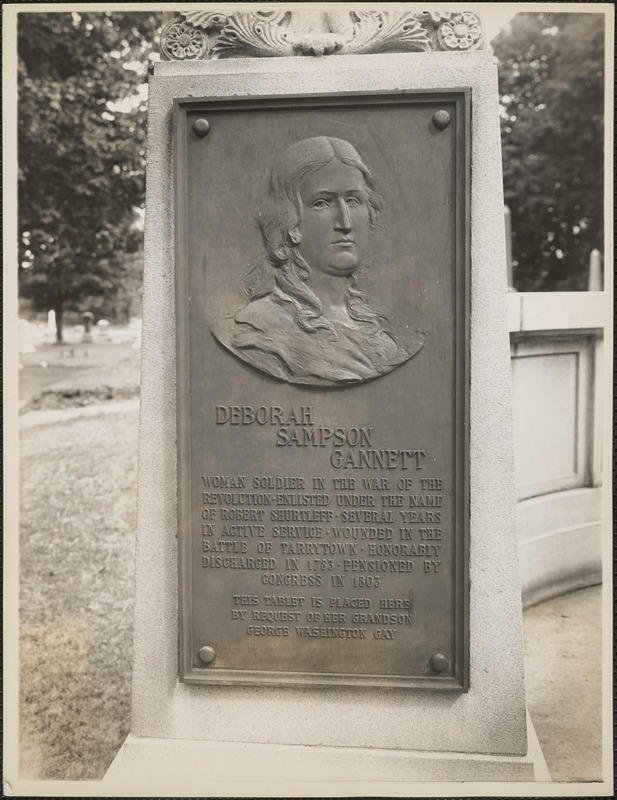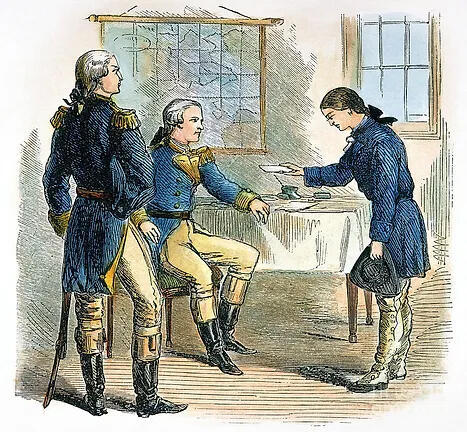Deborah Sampson covered her chest with a tight piece of cloth, adopted a man’s name and enlisted in the Continental Army’s elite light infantry in 1782. For 17 months, she marched through the Hudson River Valley, participated in dangerous reconnaissance missions and fought brutal hand-to-hand combat before a Philadelphia doctor discovered her secret in 1783.
Her battlefield service earned her an honorable discharge. Then she fought a decades-long battle for the military pension she had earned.
From Indentured Servant to Revolutionary Soldier
Sampson was born on Dec. 17, 1760, in Plympton, Massachusetts, as the descendent of prominent Pilgrim families on both sides. Her mother traced her lineage to Gov. William Bradford, while her father descended from military leader Myles Standish. Despite this distinguished ancestry, her childhood was plagued by poverty.
When her father abandoned the family, Sampson’s mother, overwhelmed and impoverished, had no choice but to split up her children. At just 10 years old, Sampson became an indentured servant to Deacon Benjamin Thomas, laboring on his farm until she turned 18. She educated herself during those years and, once freed, earned her keep as a summer schoolteacher and winter weaver. Meanwhile, tensions between the colonists and the British had begun to boil over.
The Revolutionary War had eventually scarred the Massachusetts countryside. After patriots drove the British from Boston following the Battle of Bunker Hill in 1775, the Continental Army secured most of the state. By 1780, the British had shifted their focus southward while maintaining their grip on New York City and its surrounding area.
A Woman Enlisting in the Continental Army
Women served crucial roles providing medical care and supplies for the military, but army regulations at the time explicitly banned them from enlisting in combat.
Sampson refused to accept that. She made her first enlistment attempt using the name Timothy Thayer, even collecting a signing bonus. But a neighbor recognized her at the recruitment post and exposed her disguise.
Undeterred, she tried again. On May 23, 1782, Sampson walked into the Fourth Massachusetts Regiment’s recruitment station calling herself Robert Shurtleff. This time, her disguise held. She officially joined the Continental Army.
Her physical stature helped maintain the deception. When commanders selected her for the unit’s light infantry company, they had no reason to question “his” identity — the elite unit only accepted soldiers standing at least 5 feet 5 inches tall who could maintain the rapid marching pace required for swift tactical operations. Most soldiers in her unit believed no woman could possibly meet these rigorous physical standards.
Wounded in Combat and Later Military Service
The light infantry specialized in high-risk flanking and skirmishing missions throughout the Hudson River Valley. During a fierce engagement near Tarrytown, New York, Sampson found herself in close-quarters combat. A sword slashed her forehead. Then a musket ball tore into her thigh.
Bleeding heavily, she pleaded with her fellow soldiers to leave her behind rather than take her to a field hospital, knowing medical treatment would expose her secret. They ignored her protests and carried her to a hospital. The physician stitched up her head wound, but when he was called away briefly, Sampson saw her chance. She slipped out before he could examine her leg injuries.
Back in her quarters, Sampson performed battlefield surgery on herself. Using only a penknife and sewing needle — with no anesthetic — she extracted one musket ball from deep in her thigh and closed the wound with thread. However, some of it had lodged too deep to reach. Fragments remained embedded in her leg for the rest of her life, and the wound never properly healed.
Despite this painful injury, Sampson continued her service undetected. Her performance impressed commanders so much that General John Paterson selected her as his personal aide.
In summer 1783, while on a mission in Philadelphia, Sampson collapsed with a dangerously high fever. She arrived at the hospital unconscious. The attending physician, Dr. Barnabas Binney, unwrapped the cloth around her chest while treating her and discovered the truth.
Rather than immediately report her to military authorities — a revelation that would have ended her service — Dr. Binney kept the secret. He quickly moved Sampson to his home, where his wife and daughters nursed her back to health away from military officials. On Oct. 25, 1783, she received a discharge from West Point after 17 months of service.
General Paterson, still unaware that his trusted aide was a woman, even gave Sampson travel money to help her get home. She was the only female to serve as an official soldier in the Continental Army and receive an honorable discharge during the American Revolution.

The Battle for Benefits and Paul Revere’s Support
She married Benjamin Gannet on April 7, 1785, and settled into life on his family’s farm. The couple had three children, and Sampson took on the traditional role of a farmer’s wife.
In January 1792, Sampson filed a petition with the Massachusetts State Legislature demanding the back pay the army had withheld solely because of her sex, according to the Museum of the American Revolution. The legislature voted to award her 34 pounds plus accrued interest.
But state compensation wasn’t enough to support her family and she still was not authorized a pension despite the wounds she had received in combat. In 1802, she began a year-long lecture tour about her military experiences, becoming the first American woman to do so. During these lectures, she sometimes appeared in full military uniform, demonstrating weapon drills and marching formations.
In 1804, Paul Revere visited Sampson at her Sharon farm and was moved by her circumstances. He wrote to William Eustis, the congressman representing her district, advocating on her behalf. In his letter, Revere called Sampson “much more deserving than hundreds to whom Congress have been generous,” according to the Massachusetts Historical Society’s records.
The federal government finally placed Sampson on its pension rolls in 1805, granting her an annual payment. The National Women’s History Museum identifies her as “the only woman to earn a military pension for participation in the Revolutionary army.”
Sampson died April 29, 1827, in Sharon, Massachusetts, at age 66.
Four years after her death, her husband petitioned Congress for survivor benefits as a soldier’s spouse. In 1837, a congressional committee concluded that Revolutionary War history “furnished no other similar example of female heroism, fidelity and courage.” Congress approved the payment, though Benjamin Gannet died before receiving the money.

Women in the Military Today
More than a century would pass after Sampson’s death before women gained a permanent place in the U.S. military. Women briefly served in vital non-combat roles as pilots, nurses, radio-operators, and other support roles in both world wars.
President Harry Truman finally signed the Women’s Armed Services Integration Act on June 12, 1948, permitting women to serve as regular members across all branches. However, the legislation capped female participation at two percent of total forces and barred them from combat assignments.
That combat exclusion remained in effect for decades, even as women found themselves in firefights in Afghanistan and Iraq. In January 2013, Defense Secretary Leon Panetta lifted the ban on women serving in direct ground combat roles. Then in December 2015, Defense Secretary Ash Carter opened every remaining military position to women without exception.
Women now comprise over 17.5 percent of the active-duty force, totaling more than 231,000 service members as of 2022. That represents an impressive increase from 14.6 percent in 2005.
While male enlistment has dropped sharply, women’s recruitment has held steady. Nearly 10,000 women enlisted for active Army duty in 2024, representing an 18 percent increase from the previous year, while male recruitment grew by just eight percent. The massive influx of female recruits helped the Army meet its recruiting goal for the first time in years.
The Air Force leads all branches in female representation at 22 percent, while the Marine Corps has the lowest percentage at 10 percent.
In September 2025, War Secretary Pete Hegseth announced new directives requiring all combat positions to meet what he called “the highest male standard.” Many critics noted that this could result in fewer women qualifying for some combat jobs. The policy shift has reignited debates about the role of American women in combat that began more than two centuries ago when Sampson picked up a musket and proved that courage has no gender.
Story Continues
Read the full article here



